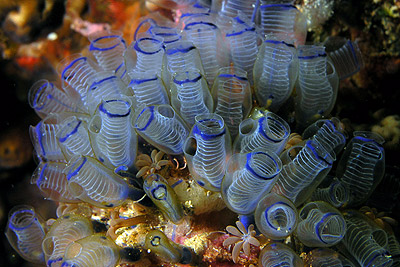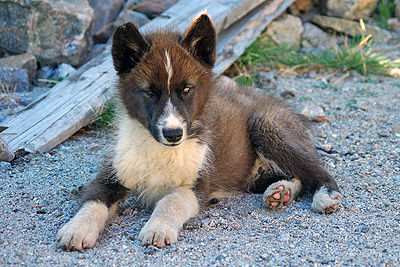Chordates are the larger group to which vertebrates belong. Larger by only a little however, the majority of chordates are vertebrates, though they all derive from the same ancestors.
The group Chordata therefore contains some members that are vertebrates and some that are invertebrates.
Chordata - Chordates - Animalia
more on
vertebrates

A colony of sea squirts,
Clavelina moluccensis, the bluebell
tunicate. This is a chordate as the free swimming larval
stage has a notochord, but is not a vertebrate, the
notochord is lost in the adult which becomes a sessile
(fixed to the spot) filter feeder.
picture - Nhongood, used under
CC3 Attribution Share Alike unported License

Two vertebrate charismatic megafauna,
Homo sapiens and Aptenodytes forsteri,
the Emperor Penguin
Photograph
by: Kristan Hutchison - National Science Foundation

Pentaceratops
a herbivorous dinosaur genus from the Late Cretaceous
period in what is now North America.
Picture used courtesy LadyofHats

A typical vertebrate, a husky
puppy (aaah)
Canis familiaris in
Greenland
Kingdom - Animalia
Phylum - Chordata
Subphylum - Vertebrata
Classes:
Basic Features of the Chordata:
When we talk about vertebrates, we really should most of the time be talking about chordates as it is this larger and higher group that has the characteristics that we consider vertebrate. All vertebrates are chordates, and almost all chordates are vertebrates apart from a few that aren't.
Chordates are animals with the following characteristics, though not all are present all through life. In humans, the phalangeal slits are present in the embryo only and then disappear. In sea squirts, the notochord is only present in the larval stage and is lost in the adult.
- Notochord, the defining characteristic of the group, a cartilaginous rod running along the dorsal surface, the back under the nerve cord.
- Pharyngeal clefts, openings from the throat to the outside, these may be used as gills.
- Dorsal nerve cord, nerves that run down the dorsal surface (back) connecting the brain with other muscles and organs
- Post anal tail, a tail extending beyond the anus (whodathunkit?).
Basic Features of the Vertebrata:
All of the characteristics of chordates above, plus:
- Backbone, this made be bony or made of cartilage (like in sharks and rays) it usually surrounds the dorsal nerve cord (spinal cord).
Vertebrates are the most obvious group of animals as they are large and therefore visible. If you ask most people to name ten animals, most if not all of them would probably be vertebrates and many of those probably mammals as we have an inbuilt bias towards things that are like we are.
Vertebrates are also one of the most successful of all animal groups, first appearing in the fossil record about 500 million years ago. They are found throughout the world in all climate zones, they have twice evolved flying (birds and bats), they have in evolutionary time left the oceans and returned again (whales and seals), developed and lost limbs (snakes) and exhibit the most complex behaviour in the known universe.
Vertebrate brains are the most complex organs on earth and have helped us to dominate the world in ways that other species have come no where near, not bad for an upright ape prone to back pain and scurvy. Back pain because we didn't originally evolve to walk upright, doing so is a compromise of skeletal engineering. Scurvy because most other vertebrates can make vitamin C whereas we can't and so get scurvy if we don't have enough in our diet.
Vertebrates are certainly amongst the most
charismatic of life-forms including the "Big
5" African safari animals: Lion, Elephant, Leopard,
Rhinoceros and Cape Buffalo, not to mention whales,
penguins and
dinosaurs.
Top banner - Amphioxus picture. Amphioxus are chordates that split off from the vertebrate line around 520 million years ago. They are a group of about 32 species of small (5cm) fish-like filter feeders found in shallow seas from the tropics to the temperate zones. They give a good indication of what the immediate ancestors of the vertebrates were probably like.
picture - Jon Houseman, used under CC3 Attribution share Alike Unported license.
